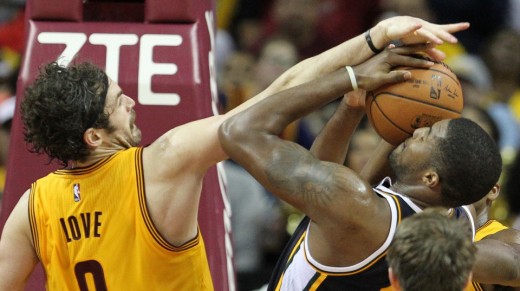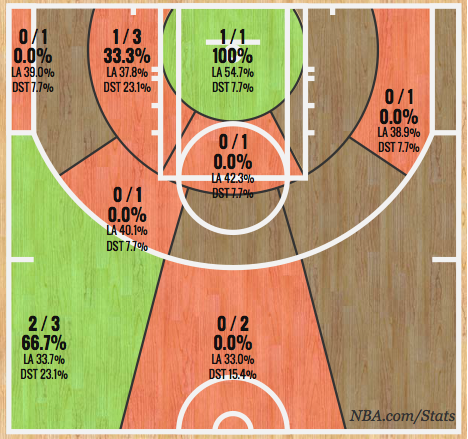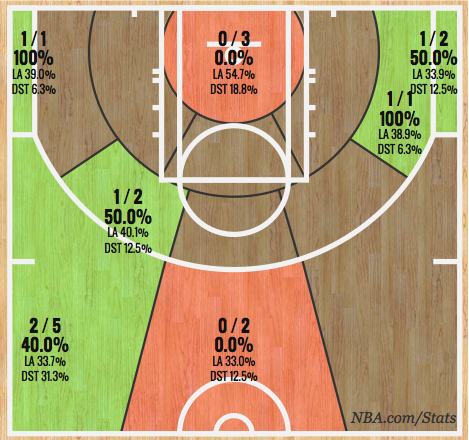The Point Four-ward: No Love for the Block
2015-11-11Four points I’m thinking about the Cleveland Cavaliers…
1.) It was good to see Kevin Love re-assert himself in the paint on Sunday against the Indiana Pacers. After two previous games in which he shot a combined 30% from the field and averaged 11.5 points per game, Love took it to the Pacers to the tune of 22 points (on 9-18 shooting, including 2-6 from three) and 19 rebounds.
It wasn’t just the point and rebound totals that were different for Love against the Pacers, it was his style of play. In his two down games, Love was reverting to his 2014-15 form of “floating” and relying heavily on the three point shot.
After starting the season strong and talking about liking to work inside out, Love posted this shooting display against the New York Knicks:
On several of these shots, Love seems bothered by the height and length of the Knicks’ rookie power forward Kristaps Porzingis. The 7-3 Porzingis was actually able to get out and use his length to challenge the shots Love was taking to try to mitigate that length… maybe get himself into a little rhythm and open up the middle to take advantage of the still not-entirely-fleet-of-foot Latvian big. In the end, Love just didn’t make shots, but Porzingis looked like he had a little something to do with that.
2.) The Sixers also feature a young, up-and-coming shot blocker in second year forward Nerlens Noel and, again, Love struggled with his outside shot. While he did attempt more shots at the rim (where he went 2-5) he sent up a whopping ten tries from deep (hitting only two) and didn’t get to the line once.
In plays like this one, you can see what Love is thinking: Noel sags off him in order to have a chance to help against penetration. So, Love can get the outside shots that he wants. In this game, again, he just didn’t hit them.
Noel, meanwhile, finished the game with two blocks — neither on Love. But was Noel’s mere presence impacting Love’s aggressiveness?
Against the Pacers — and their (relatively) smaller front court of Ian Mahinmi (an impressive 1.6 blocks per game), rookie Myles Turner (1 BPG) and revolving door Jordan Hill (0.1 BPG) — Love was able to do damage at the rim, particularly by getting out and scoring in transition and by battling for second chance points like this one. Love knew he could go at the Pacer’s front line — and, boy, did he ever.
3.) So, Utah’s big front court of 6-10 Derrick Favors and 7-1 Rudy Gobert, who came into the game second in the league in blocked shots with four a game, would pose an interesting test. Would Love continue to to float out on the perimeter and not challenge the Jazz and their length inside?
You be the judge:
On the whole, the Cavs game-planned for Gobert by trying to get into their sets quickly, so as not to give the defense of the Jazz time to set up shop. In fact, Gobert ended up without a blocked shot for the game. Love, meanwhile, missed some close looks (a hook shot that he short-armed, a put-back that bounced back out and the break-away where he tweaked his knee) so he fell back on his jumper which, especially in the first half, was falling more than it has in a while.
But did the presence of an elite shot-blocker get inside Love’s head just a little? That’s tough to say for sure, but he definitely wasn’t working around the rim with the kind of confidence he was against the Pacers.
In Love’s defense, though, when his shot left him for most of the second half, he was able to get to the line six times, where he nailed all six freebies. Overall, still a nice game for Love in the Cavs’ win… but there may come a time where Love will have to challenge some of these elite shot blockers in the paint and, right now, he’s showing that’s not his preferred battle ground.
On the season, Love’s own shot blocking is up this year, though only marginally so. A career 0.5 BPG player, Love is now swatting away opponents’ shots at a 0.8 BPG clip.
4.) Cavaliers fans have grown frustrated with Joe Harris. In his second season as a pro, the former Virginia Cavalier sharp shooter is averaging just 3.5 minutes a game, while appearing in only half of his team’s games thus far. He’s been overtaken on the depth chart by training camp invitee Jared Cunningham (a.k.a. Much Danger Ninja) and hadn’t shown tangible strides in either the Las Vegas Summer League or in this year’s preseason that Cavs GM David Griffin was probably hoping for when he selected Harris with the 33rd pick in the 2014 NBA Draft.
Meanwhile, another 2014 second rounder currently controlled by the Cavs is flourishing. Dwight Powell, acquired by the Cavs in a draft day swap that sent both him and the Brendan Haywood trade exception (nee NBA center Brendan Haywood) to the Cavs for guard Scotty Hobson and cash considerations, looks like he’s found a home with the Dallas Mavericks. In just under 22 minutes a night, the 6-11 big man out of Stanford is averaging 11.1 points and 7.7 rebounds a game.
Powell was shipped to the Celtics, along with Erik Murphy, John Lucas III, Malcolm Thomas and two second round picks for Keith Bogans. Bogans, of course, was later shipped to the Philadelphia 76ers with the trade exception the Cavs received in return being used last January to help acquire center Timofey Mozgov.
Powell hasn’t become quite the stretch big that Griffin talked about when he acquired him on draft day, scoring most of his points being active close to the basket. And, no, of course, he’s no Mozgov. Still, Powell’s been a nice little surprise for the Mavericks and an indication that, regardless of how highly shooting is valued on a LeBron James-led team, the Cavs may have overvalued Harris and, in doing so, let a good, young big man get away.




According to Nba player tracking 10 guys average more postup fgas than Love this season. Out of those ten guys, Love has a better fg % than 5 at 63%. Confirms what i have seen via the eye test, which is when love has time and has good to pretty good position, he has been money in the post. More Love postups please, and hopefully more high post touches at the elbows for good measure. Small sample size, i know, but pretty encouraging. To me, love has struggled more finishing cuts or in transition than postups. No data on that,… Read more »
Addendum to that, apparently player tracking and play type stats differ as to their results. Play type is not precisely defined whereas player tracking is, catch and reception within 15 feet of the hoop. Play type has love as having only 15 postup fgas of which he has made 12 for an 80 fg %. Not sure which is more accurate or how exactly synergy defines postups, but either way super encouraging. If the postup in play type is actually true postups, 80% is an insane fg %, which means we really need to postup love more.
Also, according to play type via synergy, out of guys with more than 15 postups on the season only Milsap has a better points per possession than love, 1.37 to 1.35.
I do love the postups by Love but sample size is still relatively tiny. I hope they continue to use Love the way they have been. In fact, when LeBron says he is smart, he means it. I think he’s “training” the team to play this way so that when Kyrie/Shump come back, they can assume the roles of Mo/Delly without really missing a beat. Mo has been putting up good numbers but imagine Kyrie doing the things he does instead of him :)
Wasn’t Jon Leuer supposed to be the guy that “we shouldn’t have given away” because of how great he looked in advanced stats? Where is he now? :)
I would caution on the Powell stuff. It’s still EXTREMELY early. Danny Green isn’t shooting that well either but he was passed on multiple times by at least 2 teams.
@pepsi: Uncle Drew is back, and he brought company. Tune in to see what happens next! #UncleDrew
https://t.co/0ogwRZEp3B
Cols will like this one!
So that’s what Ray Ray’s been up to…
I got the plan for playing the Dubs. You gotta pester Curry 94 feet every time up and down the court. I would run MD, MDN and (hopefully) IS out there for about five minutes at a time, and take turns bumping him every step he takes. Just being in the way if he walks up with someone else with the ball.
Also: I bet SK learned some rough tricks playing in Russia for a decade. He needs to whack DG a couple.
Kentavious Caldwell-Pope defended him well….it’s possible, but obviously, not easy. And not many people even have the ability to really defend him.
Raoul, that would be the beauty of the Cavs reaching the Finals completely healthy. You could basically just glue Delly to Curry for critical minutes. Delly has really improved his feel for his teammates spacing in the early going (Delly to TT is a real thing) so he could actually run the O in spots, instead of driving and praying like last Finals.
@latbbolch: Mark Cuban on misreporting about DeAndre Jordan: “You mean Chris Broussard? He’s an idiot. I take that back. My sources say he’s an idiot.”
That comment is hilarious. Love Mark Cuban
@dallasmavs: Hey @LAClippers! Good game! Have a safe trip home! ✈️???⛵️??
I was happy to see that result, and nice to see Dirk have a big game.
That’s in the running for tweet of the year, lmao!
@kporzee: tough loss.. shot I always dreamt of making. Sucks.. but gotta stay positive and we have another chance this friday vs Cavs. Go Knicks
The Nets may unexpectedly win a game.
With those numbers it sounds like Powell’s in line for 82mm
Isn’t Love just using his versatility by staying outside against big shot blockers? The article kind of frames it as some kind of character flaw like he should be trying to post up 7’6 monsters. That’s not Loves game
Worrying about role players that you may or may not have missed out on is a way to drive yourself crazy. As long as the Cavs get the big things correct, and they have, then role players will come and go.
But Powell? Who cares? He isn’t going to move the needle one way or the other. He’d be getting next to zero minutes on this team and probably wouldn’t have developed at all.
Stop worrying about end of bench guys and learn to love the team you have.
We have Love, Leb, and Irv… Print the championship shirts already damn it!!!!
Well yeah. Get those three guys and keep
Them healthy and champs
Yeah what happened to “Leb”. haven’t seen that so much this season
I’m not a big fan of second guessing draft picks. Particularly, in the NBA where you have to learn and excel at a pretty substantially different game (pace, play styles, talent quality night-to-night, balancing a checkbook/household/pressures of becoming a millionaire overnight at ~20 years old)… I don’t think I could travel back in time and convince people that, based on actual available evidence at the time, not to draft someone like Mayo or Beasley or Derrick Williams or Oden or Milicic or Embiid. I’ve watched a ton of UK basketball over the years, and if you told me Prince, Rondo,… Read more »
Especially with a 2nd round pick, which is a shot in the dark. I’m not frustrated by Joe Harris because I had low expectations to begin with, and he never showed much at any time, even when he got some run at the beginning of last year. No big deal, move on to the next guy.
Yep. 2nd round picks are basically worthless in the NBA. It’s luck if you hit on a guy that can actually play. It doesn’t happen often enough to worry about. Yes, sometimes you end up with Carlos Boozer or Draymond Greene (who I can’t stand) but mostly you end up with Joe Harris.
Wasn’t Mo Williams a second rounder?
Mark Price Paul Millsap Manu Ginobili
Ben Wallace was Undrafted.
You can find plenty of talent in the 2nd round
Interesting stuff on Love, nice piece. Love, for all his many strengths, has shown to be a guy that prefers not to challenge if he doesn’t know he can win. I think you’re right about the elite shot blockers getting him out of his game. If he could work to put a little more “sky” in his hook shot, he could overcome that. Watching LBJ hit that hook, it made me thing that both LBJ and Love could really get a lot out of a good hook shot when facing big shot blockers.
Good thing the Cavs won’t face a young, +7′ elite shot blocker in the ECF. If they face one in the first round the talent surrounding Love should be enough to get the Cavs over the hump easily.
Didn’t know that about Powell. Hopefully not another Danny Green situation.
Where a guy gets cut multiple times by multiple teams before finally realizing he’s going to have to go work at McDonalds if he doesn’t start practicing like a mad man?
That doesn’t happen all that often. So no, I don’t think it’s similar at all.
And really, we got Mozgov because of this. That’s much better than having Powell.
I don’t think the comparison was between Mozgov and Powell. It was between Joe Harris and Powell. We’d rather have Powell, hindsight being 20/20.
Certainly not like we need another PF on this team. Looks like we got a good pick in the second round in Cedi Osman though. He should be a nice pick up in two years when we can bring him over.
Hopefully, Much Danger Ninja can be our Danny Green. If he keeps working on his D and Three, why not?
because he doesn’t shoot that well.
Powell has become one of the more reliable cheap plays in daily fantasy.